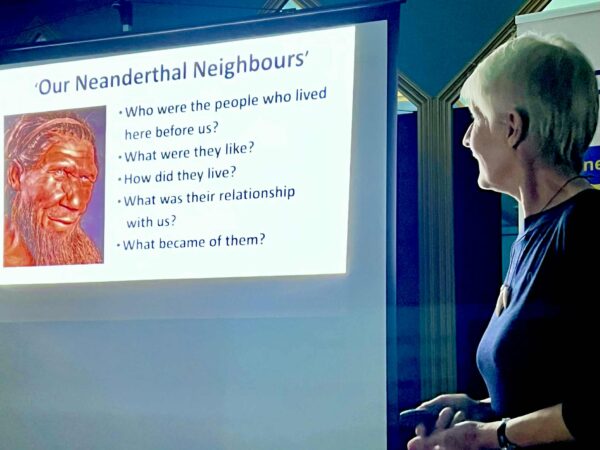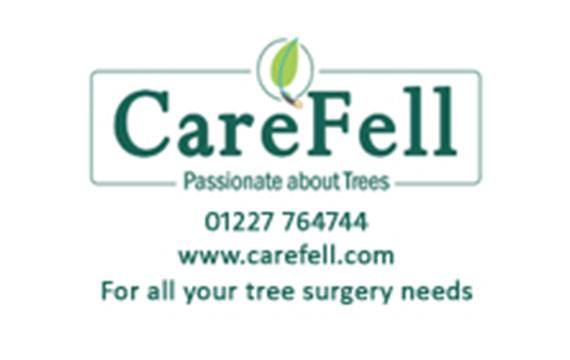Our club may be more than a hundred years old, but we’re certainly not Neanderthal – although after Anne Beecham’s talk on Neanderthals, it seems we may all have a bit of them in our DNA!

Anne, a former geologist with years of geological experience – including on oil rigs – joined us to share her post-retirement passion for human evolution and the remarkable advances made in understanding our ancient relatives. Anne took us on a “gallop through human evolution,” showing just how much – and how little – we truly know about where we come from.
Anne began by describing how her interest was sparked close to home, when she came across ancient stone tools in the hills above Elham village. These artefacts, possibly Neanderthal in origin, prompted her to explore who these early humans were, how they lived, and what became of them.
Neanderthals, we were told, were hunter gatherers that lived a nomadic lifestyle in caves and rocky shelters – so there are no “settlements” from which to learn about their lives. Instead, evidence about them in our part of Kent has mainly come from “stones not bones” – such as worked flint hand axes, spear points and scrapers found by Ken Beeching, a former farm worker, on the hills above Elham.
While our own species, Homo sapiens, evolved in Africa, Neanderthals adapted to the colder climates of Ice Age Europe and western Asia. As both species spread, Neanderthals coexisted with Homo sapiens for tens of thousands of years. Despite their reputation, they were far from brutish: skilled toolmakers, capable hunters, and social beings who cared for the injured and elderly and buried their dead. They even produced decorative artefacts like eagle talons. One such decoration is suggestive of “tally” counting. An amazing site in the Bruniquel caves in southwest France is a circle of stalagmites – constructed 174,000 years ago.
Contrary to what you might expect, Neanderthals actually had brains slightly larger than ours. Anne explained that modern humans and Neanderthals share around 99.7% of their genetic material, suggesting that the line between “them” and “us” is much finer than once thought.
We were treated to details about Neanderthal lives: their stocky build, big hands, pronounced brow ridges and wide noses suited to cold climates; their varied “opportunistic omnivore” diet of meat (e.g. bison, deer and horse), nuts, many types of plants, fungi, and fish; and their use of fire and animal skins for warmth. Evidence points to communication skills.
Neanderthals lived among formidable fauna, including mammoths, sabre-toothed cats and ancestors of lions and bears. Despite the size of these animals, Neanderthals managed to hunt and eat them. We also learned that Neanderthals as a group faced many environmental challenges and survived the peaks and troughs of dramatic temperatures variations over the last ice age. With advances in DNA research over the last decade, our understanding of Neanderthals has changed dramatically – raising new questions with each new discovery. As Anne put it, “the more you know, the more you don’t know.”
So what happened to them? Neanderthals lived for approximately 350,000 years. But by around 40,000 years ago, Neanderthals had disappeared. Anne outlined several possible explanations: competition with Homo sapiens for resources, climatic shifts, new diseases, genetic isolation of small Neanderthal populations or perhaps simple interbreeding and assimilation into our expanding Homo sapiens population. DNA evidence reveals Interbreeding between Neanderthals and Homo sapiens occurred far more frequently than was once thought – there is also evidence from a “mixed” 13-year-old girl with a neanderthal mother and a father from another Homo species. In all likelihood, it was a mix of pressures rather than a single event, that led to their disappearance.
Anne ended with a thought-provoking look at the traces of our Neanderthal ancestors that still linger in us today. She spoke of “Neanderthal inheritance”: genetics that gave physical traits like fair skin, freckles, or (possibly) red hair, and the genes associated nowadays with characteristics such as greater protection from respiratory pathogens, susceptibility to nicotine addiction or to autoimmune diseases such as Crohn’s disease and type 2 diabetes. It seems the Neanderthal legacy is very much alive.
The talk concluded with the classic humorous picture showing the “evolution of modern man”, which ended with man hunched over a computer. Mankind had made logarithmic leaps forward over the past few years – and is now on the cusp of another major change as AI enters the world and impacts our future lives.
Following a few questions from our members our President Raj led the vote of thanks – with everyone giving Anne a warm round of applause.
Picture: Anne pictured during her recent talk. Picture credit: Rotary Club of Canterbury.


